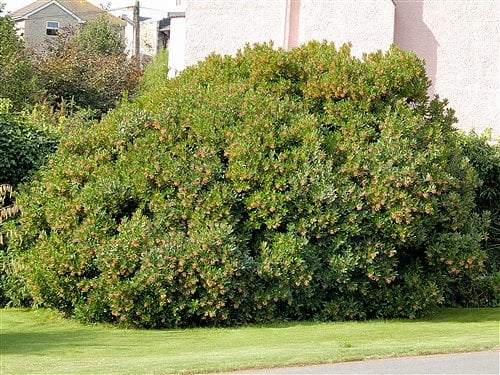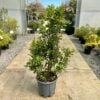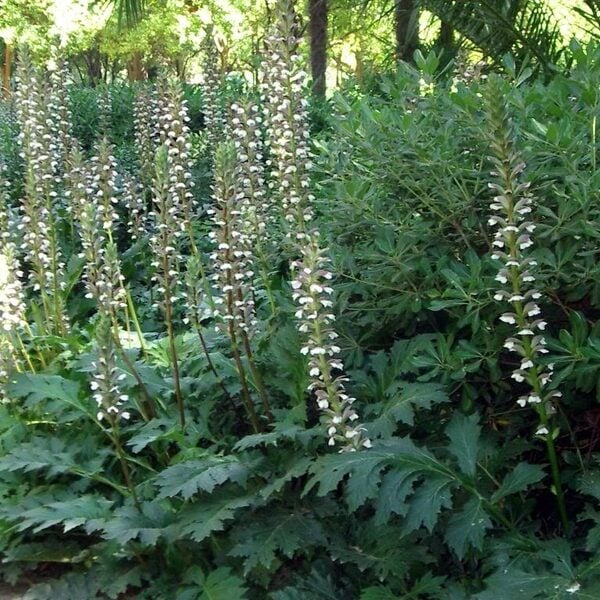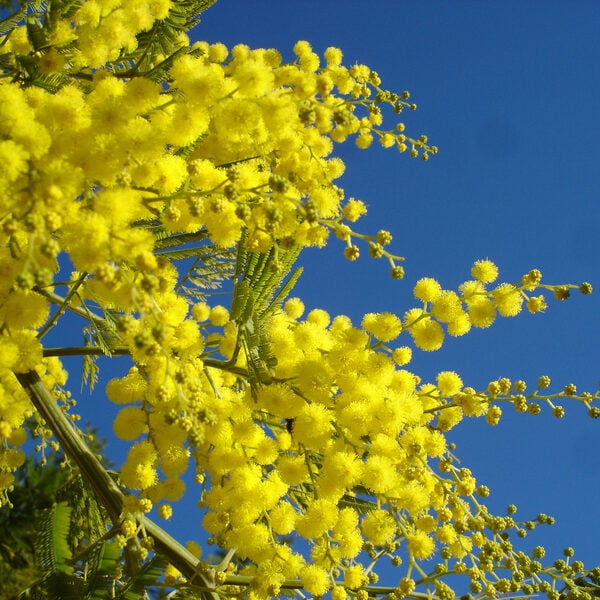Arbutus unedo (Kilarney Strawberry Tree)
Well know shapely little evergreen tree: 20ft in 30 years. Needs well drained soil. Masses of little white flowers followed by fruits that look (a bit) like strawberries. Please contact us for stock availability and sizes.

Hardiness level Green
This is native from south-west Ireland down through Portugal and along the Mediterranean as far as Turkey. It's native to the U.K. but is frequently spotted for it's lovely dome shaped evergreen-ness in gardens all over Britain - particularly near the coast. It's one of the parents of our much sought after hybrid Arbutus x andrachnoides.
Like all Strawberry Trees, it needs sharp drainage but unlike all Strawberry Trees, this one doesn't like thin soil over chalk. It's one of those slow-but-worth-it trees. When you see the beautiful dome shaped little trees 20ft tall and 20ft wide, they may well be over 50 years old. That shape is either a function of age or someone's been up a ladder with a pair of shears. They also need plenty of light to do their thing. The (slightly) strawberry like fruits are (slightly) edible but look nice when they cover an old tree. Flowers are born in autumn and are white and bell shaped and profuse. They're similar to the closely related Pieris from China and Japan.
Their natural habit is to be multistemmed and as the bark is reddish and flaky, much fun can be had clearing growth off the stems to expose them. They also (like all Strawberry Trees) have lots of dead twigs in them which do the tree no harm but much visual improvement is made by removing them. Time consuming but worth it. Always a good plant for practising your Creative Maintenance on.
Big old trees with lovely dense rounded heads are frequent near the south coast of England. The one in the picture is in the public gardens at Southsea in Hampshire. Quite a young plant but a nice bit of Creative Maintenance.
The curious Latin name 'unedo' is said to derive from a comment made by the Roman naturalist Pliny the Elder - translated as 'I only eat one'. Undoubtedly referring to its insipid taste, you'd have to be bloody hungry to eat more than one.
Propagated by cuttings.
All the Strawberry Trees are prone to getting black spots on their leaves by the end of winter. It doesn't appear to be a fungal problem but is aggravated by the plant being less than content - usually either because it's in a pot or its roots are dying back due to over wet conditions. It's also a part of the natural disintegration and fall of old leaves before the new ones appear in the spring. There seems to be no treatment other than removing unsightly leaves by hand or be patient - the spring always brings nice fresh new leaves and the spotty ones fall.
N.B. When clipping several plants with the same tool, have a bucket containing a 5% bleach solution and swish your blades around for 30 seconds between plants to sterilise them. This will help avoid the chance of cross contamination of disease.
As with all woody plants, plant high, exposing as much of the taper at the base of the trunk as possible. Allowing soil to accumulate round the base of a tree can be fatal. Keep very well watered when first planted.
Additional Information |
|
|---|---|
| Soil Type | |
| Light | |
| Plant Type | |
| Continent of Origin | |
| Specialist Plants | |
| Features | |
| Tree Size | |
| Situation | Coastal, Exposed (To wind and sun), Mild City Gardens, Sheltered Garden |
| Flower Colour | |
| Hardiness | |























